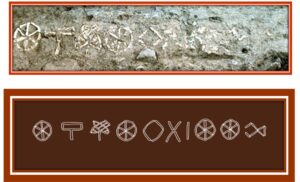By Dr. Saikrishna Gajavelly, CEO Mera Hoardings
Out Of Home Advertising Roots Found In Ancient India Date Backs To 3-5000Bc
Outdoor advertising is one of the most affordable forms of marketing in the Sign industry. Even the ancient world had Billboards or Signboards something a lot like them. Indus valley civilization is the most ancient civilization in the world. A group of researchers around the globe have used carbon dating techniques on animal remains and pottery fragments to conclude that the Indus Valley settlements could be 8,000 years old. Dholavira also a city in the Indus Valley Civilization, More than 4000 years ago, Dholavira was one of the largest cities of its time.
You may know that billboards started in ancient India. Dholavira is a large archaeological site of the ancient Indus valley civilization, situated in the Kutch district of Gujarat in Western India. One of the most interesting and significant discoveries at Dholavira is the billboard found in the northern gateway of the city and is often called the “Dholavira Signboard”. It could be the world’s oldest signboard, undecipherable of dates back to the 5 – 3000 BC.

The credit of finding this Hoarding with 10 inscribed symbols goes to The Archaeological Survey of India (ASI), by a team led by Prof. R. S. Bisht. The billboard originally was designed with set pieces of the mineral gypsum to form ten large symbols on a big wooden board. At some point, the board fell flat on its face. The wood decayed, but the arrangement of the symbols inscribed survived. The size of the symbols of the billboard is comparable to large bricks that were used in nearby walls. Each sign is about 37 cm (15 in) high and the board on which letters were inscribed was about 3 m (9.8 ft) long. The size of letters being big that could be viewed from a distance, and the width of the board matching with the width of the northern gateway of the Dholavira citadel, it is conjectured to be a large advertising board. The board is long with 10 Indus symbols and one circular symbol appearing four times. Its large size and public nature make it a key piece of evidence cited by scholars who opine that the Indus symbols represent a different type of communication. Another four-sign inscription with big size letters on sandstone was also found at this site, considered the first of such inscription on a sand stone at any of the excavation sites. The script has thirty seven cm tall and 6-10 cm wide three large Indus signs, running from right to left, and there appears to be a fourth sign too. The symbols or script also matching with modern out of home advertising formats.

The archaeologists found the symbols by looking for ancient road systems–often, they write, inscriptions are found along city entrance, three walls enclosed it, and its gates opened onto broad plazas, busy workshops and spacious stadiums thoroughfares and at junctions. That sounds just like a modern-day city, where billboards are often oriented toward areas highly trafficked by walkers or drivers. It’s a fascinating parallel between today’s modern landscape and its ancient precedents.
__________

Dr. Saikrishna Gajavelly is the Founder and CEO of MERA HOARDINGS has been in the outdoor industry for over 12 years based out of India. He completed his master’s degree in advertising and marketing in 2008 then started the journey in the out-of-home advertising industry. He completed his Ph.D. and received his doctorate in “Ancient Indian Vedic Management” in 2010, Started research and development institute on ancient Indian science and technology (Purna Vedas). His knowledge in research and development fields helps to develop innovations in the outdoor advertising industry.
[wpforms id=”9787″]
Paid Adverrisement

















